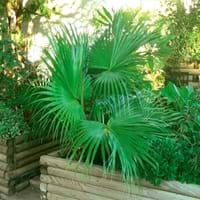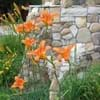Life Span
Perennial
Perennial
Type
Bulb or Corm or Tuber
Palm or Cycad
Origin
North America, Europe, Africa, Asia
United States, Southeastern United States, South-Central United States
Types
White lily, orange lily, Lily of the valley
Not Available
Number of Varieties
Not Available
Habitat
Not Available
Floodplains, Lowland, River side, Swamps
USDA Hardiness Zone
2-8
7-12
Sunset Zone
21,22
H1, H2, 3b, 4, 5, 6, 7, 8, 9, 12, 13, 14, 15, 16, 17, 19, 21, 22, 23, 24
Habit
Upright/Erect
Clump-Forming
Flower Color
White, Yellow, Red, Green, Purple, Gold, Pink, Rose, Peach, Burgundy, Bronze
Ivory
Flower Color Modifier
Bicolor
Bicolor
Fruit Color
Yellow green, Sandy Brown
Chocolate, Black
Leaf Color in Spring
Green, Dark Green
Green, Gray Green, Dark Green
Leaf Color in Summer
Light Green
Gray Green, Dark Green
Leaf Color in Fall
Several shades of Green
Green, Gray Green, Dark Green
Leaf Color in Winter
Light Green
Olive, Gray Green, Dark Green
Leaf Shape
Long Linear
Circular, dissected, long and linear
Plant Season
Spring, Summer, Fall
Spring, Summer, Fall, Winter
Sunlight
Full Sun, Partial Sun, Partial shade
Full Sun, Partial Sun, Partial shade
Type of Soil
Clay, Loam, Sand
Clay, Loam, Sand
The pH of Soil
Acidic, Neutral, Alkaline
Acidic, Neutral, Alkaline
Soil Drainage
Well drained
Poorly Drained
Bloom Time
Not Available
Early Summer
Tolerances
Drought
Wet Site, Salt
Where to Plant?
Container, Ground, Pot
Container, Ground
How to Plant?
Seedlings
Seedlings, Stem Planting
Plant Maintenance
Medium
Medium
Watering Requirements
Do Not over Water
Do Not over Water, Never Over-water, Requires regular watering, Requires watering in the growing season
In Summer
Lots of watering
Lots of watering
In Spring
Moderate
Moderate
In Winter
Average Water
Average Water
Soil pH
Acidic, Neutral, Alkaline
Acidic, Neutral, Alkaline
Soil Type
Clay, Loam, Sand
Clay, Loam, Sand
Soil Drainage Capacity
Well drained
Poorly Drained
Sun Exposure
Full Sun, Partial Sun, Partial shade
Full Sun, Partial Sun, Partial shade
Pruning
Prune in early spring, Prune in fall, Remove dead or diseased plant parts
Remove damaged leaves, Remove dead leaves
Fertilizers
All-Purpose Liquid Fertilizer, Fertilize only when soil is poor
fertilize every 2-3 weeks while growing
Pests and Diseases
Lily Beetle
Insects
Plant Tolerance
Drought
Drought
Flowers
Showy
Insignificant
Flower Petal Number
Single
Single
Foliage Texture
Not Available
Bold
Foliage Sheen
Not Available
Matte
Attracts
Not Available
Birds
Allergy
Not Available
Avoid during Pregnancy
Aesthetic Uses
Beautification, Showy Purposes
Beautification, Landscape Designing, Showy Purposes
Beauty Benefits
Making cosmetics
Not Available
Environmental Uses
Not Available
Air purification, Food for insects, Prevent Soil Erosion
Medicinal Uses
Burns, Diuretic, Heart problems
Asthma, Baldness, Cold, Cough, Migraines, Sore throat
Part of Plant Used
Whole plant
Whole plant
Other Uses
Cosmetics, Oil is used for aromatherapy, Used As Food, Used as Ornamental plant, Used for its medicinal properties
Decoration Purposes, Employed in herbal medicine, Showy Purposes, Used as Ornamental plant, Used for its medicinal properties
Used As Indoor Plant
Yes
Yes
Used As Outdoor Plant
Yes
Yes
Garden Design
Alpine, Container, Cutflower, Feature Plant, Mixed Border, Wildflower
Bog Garden, Feature Plant, Foundation, Hedges, Mixed Border, Tropical
Botanical Name
LILIUM
SABAL minor
Common Name
Lily
Bush Palmetto, Dwarf Palmetto, Little Blue Stem, Swamp Palmetto
In Hindi
लिली
बौना पल्मेट्टो
In German
Lilie
Zwerg Palmetto
In French
Lis
Palmetto nain
In Spanish
Lirio
Palmetto enano
In Greek
Κρίνος
Νάνος Palmetto
In Portuguese
Lírio
Palmetto anão
In Polish
Lilia
Dwarf Palmetto
In Latin
lilium
Pumilio Palmetto
Phylum
Tracheobionta
Magnoliophyta
Class
Liliopsida
Liliopsida
Family
Liliaceae
Arecaceae
Clade
Angiosperms, Monocots
Angiosperms, Commelinids, Monocots
Tribe
Lilieae
Not Available
Subfamily
Lilioideae
Coryphoideae
Season and Care of Lily and Dwarf Palmetto
Season and care of Lily and Dwarf Palmetto is important to know. While considering everything about Lily and Dwarf Palmetto Care, growing season is an essential factor. Lily season is Spring, Summer and Fall and Dwarf Palmetto season is Spring, Summer and Fall. The type of soil for Lily is Clay, Loam, Sand and for Dwarf Palmetto is Clay, Loam, Sand while the PH of soil for Lily is Acidic, Neutral, Alkaline and for Dwarf Palmetto is Acidic, Neutral, Alkaline.
Lily and Dwarf Palmetto Physical Information
Lily and Dwarf Palmetto physical information is very important for comparison. Lily height is 30.00 cm and width 30.00 cm whereas Dwarf Palmetto height is 240.00 cm and width 240.00 cm. The color specification of Lily and Dwarf Palmetto are as follows:
Lily flower color: White, Yellow, Red, Green, Purple, Gold, Pink, Rose, Peach, Burgundy and Bronze
Lily leaf color: Green and Dark Green
Dwarf Palmetto flower color: Ivory
- Dwarf Palmetto leaf color: Green, Gray Green and Dark Green
Care of Lily and Dwarf Palmetto
Care of Lily and Dwarf Palmetto include pruning, fertilizers, watering etc. Lily pruning is done Prune in early spring, Prune in fall and Remove dead or diseased plant parts and Dwarf Palmetto pruning is done Remove damaged leaves and Remove dead leaves. In summer Lily needs Lots of watering and in winter, it needs Average Water. Whereas, in summer Dwarf Palmetto needs Lots of watering and in winter, it needs Average Water.





